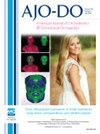Sex-related difference in self-reported pain intensity at early stages of orthodontic treatment with multibracket fixed appliances, clear aligners, and interproximal elastic separators: A systematic review and meta-analysis
IF 3
2区 医学
Q1 DENTISTRY, ORAL SURGERY & MEDICINE
American Journal of Orthodontics and Dentofacial Orthopedics
Pub Date : 2025-05-08
DOI:10.1016/j.ajodo.2025.02.018
引用次数: 0
Abstract
Introduction
Sex dimorphism in pain has been suggested in medicine and demonstrated in oral disease prevalence. However, contradictory findings are present regarding orthodontic pain perception. This study summarized sex-related differences in pain perception in healthy patients during the initial stages of orthodontic treatment and systematically explored sex-based analysis in orthodontic pain literature.
Methods
Seven databases (PubMed, EMBASE, CINAHL, DOSS, Web of Science, Cochrane’s Database of Systematic Reviews, and CENTRAL) and gray literature were systematically searched in November 2023 for original prospective studies in healthy humans and published in the English language that analyzed sex-related differences in pain intensity within 1 week of application of multibracket fixed appliance, clear aligners, or interproximal elastic separators. Quality assessment was performed with the Joanna Briggs Institute Critical Appraisal Checklist. Sex-related differences were extracted at 24 hours and day 7. The meta-analysis summarized the standardized mean difference, with the quality of evidence evaluated by using the Grading of Recommendations Assessment, Development, and Evaluation approach.
Results
The search retrieved 12,750 articles; 5961 were screened, and 284 were selected for full-text review. Forty studies (2999 participants; 57.0% females) were included. Study quality was good (82.5%) and fair (17.5%). At 24 hours, 77.3% did not reveal sex-related differences in pain perception, whereas 15.9% and 6.8% suggested significantly higher female and male predilection, respectively. At day 7, 79.3% did not observe significant differences, whereas 20.7% supported higher pain intensity among females. The meta-analysis (n = 7) indicated no significant sex-related difference (pooled effect size between −0.34 [95% confidence interval {CI}, −0.82 to 0.14] and 0.33 [95% CI, −0.77 to 1.43]), except for interproximal elastics at day 7 among females (effect size −0.49 [95% CI −0.80 to −0.18]). The certainty of the evidence was low to moderate. Despite a rise in publications on orthodontic pain assessment, few studies provided sex-based analysis.
Conclusions
Most studies did not find significant sex-related differences in pain perception during the initial stages of orthodontic treatment. Sex-based analysis was rarely conducted.
多支架固定矫治器、透明矫正器和近端间弹性分离器治疗早期自我报告疼痛强度的性别差异:一项系统回顾和荟萃分析。
简介:在医学上提出了疼痛的性别二态性,并在口腔疾病的患病率中得到了证明。然而,关于正畸疼痛感知存在矛盾的发现。本研究总结了健康患者在正畸治疗初期疼痛感知的性别差异,并系统探讨了正畸疼痛文献中基于性别的分析。方法:系统检索7个数据库(PubMed、EMBASE、CINAHL、DOSS、Web of Science、Cochrane’s Database of Systematic Reviews和CENTRAL)和灰色文献,于2023年11月在健康人群中进行原始前瞻性研究,并以英文发表,分析使用多支架固定矫正器、透明矫直器或近端间弹性分离器后1周内疼痛强度的性别差异。质量评估采用乔安娜布里格斯研究所关键评估清单进行。在24小时和第7天提取性别相关差异。荟萃分析总结了标准化的平均差异,并采用分级推荐评估、发展和评价方法评估证据质量。结果:检索到12750篇文章;共筛选5961篇,选择284篇进行全文综述。40项研究(2999名参与者;57.0%为女性)。研究质量良好(82.5%),公平(17.5%)。在24小时内,77.3%的受试者在疼痛感知上没有性别差异,而15.9%和6.8%的受试者分别表现出明显更高的女性和男性偏好。在第7天,79.3%的人没有观察到显著差异,而20.7%的人支持女性更高的疼痛强度。meta分析(n = 7)显示,除女性第7天近端间弹性外,无显著的性别相关差异(合并效应值在-0.34[95%可信区间{CI}, -0.82至0.14]和0.33 [95% CI, -0.77至1.43]之间)(效应值为-0.49 [95% CI -0.80至-0.18])。证据的确定性从低到中等。尽管关于正畸疼痛评估的出版物有所增加,但很少有研究提供基于性别的分析。结论:大多数研究没有发现在正畸治疗初期疼痛感知的显著性相关差异。很少进行基于性别的分析。
本文章由计算机程序翻译,如有差异,请以英文原文为准。
求助全文
约1分钟内获得全文
求助全文
来源期刊
CiteScore
4.80
自引率
13.30%
发文量
432
审稿时长
66 days
期刊介绍:
Published for more than 100 years, the American Journal of Orthodontics and Dentofacial Orthopedics remains the leading orthodontic resource. It is the official publication of the American Association of Orthodontists, its constituent societies, the American Board of Orthodontics, and the College of Diplomates of the American Board of Orthodontics. Each month its readers have access to original peer-reviewed articles that examine all phases of orthodontic treatment. Illustrated throughout, the publication includes tables, color photographs, and statistical data. Coverage includes successful diagnostic procedures, imaging techniques, bracket and archwire materials, extraction and impaction concerns, orthognathic surgery, TMJ disorders, removable appliances, and adult therapy.

 求助内容:
求助内容: 应助结果提醒方式:
应助结果提醒方式:


